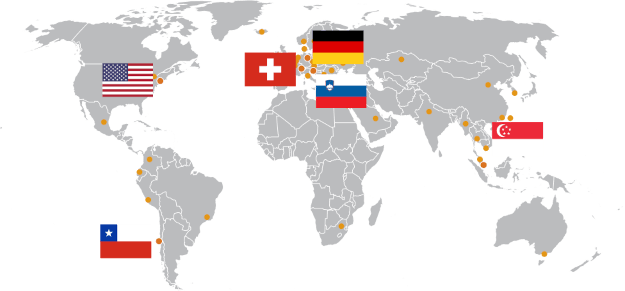Therapy Session
Dynamic Range of the Lokomat BWS
The LokomatPro Body Weight Support (BWS) system it is a unique system that adjusts to the physiologic vertical movement of the patient ensuring precise unloading during the all gait cycle To ensure this precise unloading the therapist needs to bring the patient to the dynamic range of the BWS. The patient walks in the dynamic range as soon as the orange indicator on the column of the Lokomat is moving up and down within the range of the vertical gray bar. In this video we will show you how to reach the dynamic range of the Lokomat BWS ensuring the safety of the patient ( safe walk) and then providing an appropriate loading for the patient (physiological walk).


How do I Define the Optimal Body Weight Support (BWS) Value for Individual Patients?
Initial configuration and ongoing adjustments of the BWS level during Lokomat sessions are key variables of gait training. The aim is always to provide a challenging training in a safe environment. In terms of BWS, this means finding the value where, enough support is provided to allow an upright position, yet reduced to a minimum to provide as much loading as possible.
The default starting value is 50% of the patient’s total body weight. This is based on the experience of Lokomat users who determined that most patients can start a training session at this value. However, it should be adjusted according to the patient’s ability and condition.
What are the criteria for determining the appropriate BWS value?
Whenever possible the maximal load should be applied to the patient. This maintains the appropriate sensory input during the gait cycle and challenges the patient’s entire body. Once a safe walk is achieved, we recommend reducing the BWS to <40% of total weight.
- Patient’s Knees: The main indicator to recognize if the value is correct is the patient’s ability to extend his knee. A sufficient amount of BWS should be maintained to allow the patient to achieve the appropriate gait pattern; pay attention to his ability to extend his hips and knees in stance phase and maintain his trunk upright during the gait cycle.
Training Progression: Once you find a level of BWS that allows for a good gait pattern with good kinematics, it is important to continue challenging your patient. This can be done either by gradually decreasing the amount of BWS, or by changing other gait parameters (e.g. speed, guidance force).
How do I define the BWS value at first?
During the first session you may not know how much support the patient needs, we therefore recommend the following:
- Start with walking in the air at the default value (50% of the patient’s body weight).
- Bring the patient down onto the treadmill until you reach a dynamic range of the BWS.
If, when lowering the patient, you cannot reach a dynamic BWS because the patient cannot carry 50% of his weight and the training session would not be safe (i.e. the knee does not extend during stance phase), then increase the BWS value. - Once the patient is walking in a dynamic range, you can gradually reduce the BWS value while taking care to monitor the patient’s ability to extend his knees. The goal of reducing the BWS value is to support the patient only as much as he needs: we want maximum challenge for the patient but always in a safe training environment.
These recommendations are based on the feedback of experienced Lokomat users.
How do I Define the Optimal Speed for Each Patient?
The Lokomat starts with a default value of 1.5km/h. However, the optimal speed value in order to challenge patients during Lokomat therapy is different for each patient depending on his overall health condition, experience with the Lokomat as well as the individual training goal. Here we provide recommendations to support you defining the optimal speed for each patient.
How do I choose the appropriate speed value for the start if therapy and during training progression?
For the first training session the speed value should not be chosen too fast so that the patient has the ability to accustom to the device and follow the correct gait pattern; it should not be chosen too slowly to enable smooth movements. According to the feedback from experienced Lokomat users for the first training session a speed value between 1.5 and 2.0 km/h seems to be selected most frequently. For children the value is smaller, ranging from 1.0 to 1.5 km/h.
As soon as a safe and nice walking pattern has been established and the patient has been accustomed to walking in the orthosis, increasing the speed value is recommended to challenge the patient during the entire training session. We therefore recommend selecting the highest speed value at which the patient is still able to maintain a nice walking pattern. At the same time the speed should be chosen in accordance with the patients abilities to train for a complete training session.
When does it make sense to select higher or lower speed values?
Higher Speed Values
- Should be chosen when the gait pattern seems not physiological due to a low speed; increasing the speed might help the walking pattern to look “smoother” (Reisman et al., 2009; Tyrell et al., 2011)
- Imply more number of repetitions and increase the challenge for the patient during the training session. A challenge point optimization is required to provide sufficient afferent feedback and positively influence neuroplastic events in particularly early after injury (Pohl et al., 2002; Lamontagne & Fung, 2004; Miller et al., 2008; Outermans et al., 2010; Wada et al., 2010; Kuys et al, 2011).
- Make sure that the speed value is continuously increased over training progression to ensure a challenging walking session and support each patients potential for functional recovery (Andriacchi et al., 1977; Wagenaar & Beek, 1992; Wagenaar & van Emmerik, 1995)
- When the training goal is to enhance an “automatized” gait pattern during over ground walking a high speed value during the training session is required (Hesse et al., 2001; Kwakkel & Wagenaar, 2002).
- If patients are already able to walk but the training goal is to further increase their comfortable walking speed overground an increased speed value during Lokomat assisted training is required.
Lower Speed Values
Despite the fact that a high speed value is required in order to sufficiently challenge patients during their walking session lower speed values may be recommended:
- During the first training sessions, so that the patient can accustom to the orthosis and the walking pattern.
- The speed value needs to be reduced if it is too high for a patient to endure a whole training session.
- When the training requires time to focus on a specific movement for example consciously extending the knee during stance phase (Nogueira et la., 2013).
- For consciously activating muscle contraction and recruiting muscle fibers for specific muscle strength training.
- In patients with spasticity when starting the training session until the muscle tone regulates and adapts to the movement. A high speed can enhance a spastic reaction which could cause the orthosis to stop for safety reasons (Bohannon & Andrews, 1990).
What do I need to consider when changing the speed value?
- The step length should be adapted to the speed.
- The orthosis speed value should be adjusted (you can also us the automatic setting).
- The hip offset may require adjustments (towards extension).
- If the quality of the movement will be affected, e.g. heel strike at initial contact.
- The joints need to be able to support the increasing impact.
References:
Tyrell CM, Roos MA, Rudolph KS, Reisman DS (2011) Influence of systematic increases in treadmill walking speed on gait kinematics after stroke. Phys Ther; 91(3):392-403
Hesse S, Werner C, Paul T, Bardeleben A, Chaler J (2001) Influence of walking speed on lower limb muscle activity and energy consumption during treadmill walking of hemiparetic patients. Arch Phys Med Rehabil ; 82(11):1547-50
Bohannon RW, Andrews AW (1990) Correlation of knee extensor muscle torque and spasticity with gait speed in patients with stroke. Arch Phys Med Rehabil 1990,71:330–3.
Lamontagne A, Fung J (2004) Faster is better: Implications for speed-intensive gait training after stroke. Stroke. 2004;35:2543-2548
Nogueira LAC, dos Santos LT, Sabino PG, Alvarenga RMP, Thuler LCS (2013) Factors for lower walking speed in persons with Multiple Sclerosis. Multiple Sclerosis International, 1-8.
Reisman DS, Rudolph KS, Farquhar WB (2009) Influence of speed on walking economy poststroke. Neurorehabil Neural Repair. 2009 Jul-Aug;23(6):529-34.
Miller EW, Combs SA, Fish C, Bense B, Owens A, Burch A (2008) Running training after stroke: a single-subject report. Phys Ther, 88:511–522.
Pohl M, Mehrholz J, Ritschel C, Ruckriem S (2002) Speed-dependent treadmill training in ambulatory hemiparetic stroke patients: a randomized controlled trial. Stroke 2002, 33:553–558.
Wada Y, Kondo I, Sonoda S, Miyasaka H, Teranishi T, Nagai S, Saitoh E (2010) Preliminary trial to increase gait velocity with high speed treadmill training for patients with hemiplegia. Am J Phys Med Rehabil, 89:683–687.
Outermans JC, van Peppen RP, Wittink H, Takken T, Kwakkel G (2010) Effects of a high-intensity task-oriented training on gait performance early after stroke: a pilot study. Clin Rehabil, 24:979–987.
Kuys SS, Brauer SG, Ada L (2011) Higher-intensity treadmill walking during rehabilitation after stroke in feasible and not detrimental to walking pattern or quality: a pilot randomized trial. Clin Rehabil, 25:316–326.
Kwakkel G, Wagenaar RC (2002) Effect of duration of upper- and lower-extremity rehabilitation sessions and walking speed on recovery of interlimb coordination in hemiplegic gait. Phys Ther; 82:432-448.
Andriacchi TP, Ogle JA, Galante JO (1977) Walking speed as a basis for normal and abnormal gait measurements. J Biomech;10:261–268.
Wagenaar RC, Beek WJ. (1992) Hemiplegic gait: a kinematic analysis using walking speed as a basis. J Biomech;25:1007–1015.
Wagenaar RC, van Emmerik REA (1995) Relearning dynamics after stroke. In: Van der Kamp, et al, eds. Movement Disorders: Proceedings on the First Symposium of the Research Institute for Fundamental and Clinical Human Movement Sciences: 51–77.
What can I do if my Patient is not Extending his Knee During Stance Phase?
As you have probably experienced, some patients lack knee extension during stance phase. Lack of knee extension may be caused by different reasons. The Lokomat provides a number of adjustments to ensure proper gait kinematics during walking; the challenge is identifying the cause so as to properly adjust. Below are a few considerations in order to make sure the patient has good knee extension during stance phase.
1. Are the cuffs properly tightened?
Check if the cuffs are loose, particularly the upper cuff. They need to be properly tightened.
2. Is the height of the Lokomat knee axis properly adjusted to the patient?
Double check the knee height. If the knee axis of the Lokomat is below the knee axis of your patient this may cause your patient to be “pushed down” during stance phase. If this is the case, double check (a) that the hip axis height is correctly aligned and (b) whether you set the upper leg too long.
3. Did you properly adjust the sagittal plane setting?
When the Lokomat orthosis is fully extended, the patient’s knee should be too. This is particularly visible at the end of the swing phase. If this is not the case, lift the patient, click on “stop” and re-adjust the sagittal settings by moving the lower cuff forwards. Before starting again, check the knee extension by manually moving the orthosis.
A patient’s knee can be extended during stance phase by moving the upper cuff backwards. As you are adjusting the cuffs, ensure that you are not hyperextending the patient’s knee.
4. Is the BWS value appropriate?
It might be the case that either the BWS value is too high or too low. If it’s too low, the patient cannot support his own weight and his knees will buckle. If the BWS value is set too high, the patient won’t have enough loading to activate a muscle response.
5. Is the patient walking with dynamic BWS enabled?
Make sure the patient is walking within the dynamic range of the body weight support. This is necessary for the patient to have enough loading. Using a static range means he is still “lifted”. This is also important to ensure constant support, as vertical displacement on the gait cycle needs to be adapted in order to avoid extreme variations on the value.
You can ensure the patient remains in a dynamic range by using the automatic dynamic function (“dyn”). This is particularly useful when changing the value of BWS.
6. Is the patient not actively participating or getting tired?
Make sure the patient stays alert and maintains effort during walking. Your patient must remain as active as possible in the Lokomat orthosis during stance phase. Verbal and physical cues to “stand up” or “be tall” might be helpful.
If the patient is tiring out, you can increase the body weight support or guidance force. If that doesn’t work, it might be time to end the session.
Physiological Walk Adjustments
Please note that this video shows the physiological walk adjustments with the Lokocontrol Software V6.2 with the FreeD module.
If you are using a different software on your Lokomat, the adjustments are still the same, you only have a different software interface.


